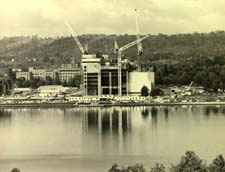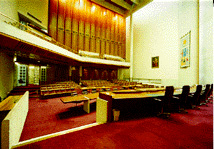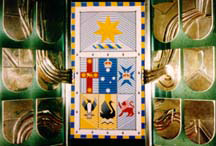- Introduction
- Structural features
- Evolution of construction of the building
- Design concept and architectural rationale
- The Public Hall
- Courtroom 1
- Courtroom 2
- Courtroom 3
Oral History Podcast of the 40th Anniversary of the High Court Building
An oral history project was commissioned to celebrate the 40th anniversary of the opening of the building of the High Court in Canberra. The High Court is a unique and architecturally significant building. Its design was the culmination of an international competition and its construction took place between 1976 and 1980. Its interior design, artworks and furnishings were integral to the effort to construct a building for the nation which reflected the significance of the High Court at the apex of the judicial branch of government.
This project resulted in a series of four podcasts focused on the construction phase of the building, its opening, and the experiences of and challenges faced by the architects, engineers, designers and artists in that phase of the building’s history.
The collaborative team of Emma Russell, History At Work; Bryce Grunden, Sound Environment; David Huxtable, LookEar; and Leo Martin, Line Of Sight Heritage conducted the research, oral history, script writing and podcast production.
Part 1: The Vision: This podcast is about the inspiration and the drive behind the decision to provide the High Court with its own magnificent building in the capital.
Part 2: The Debate: It is not possible to have a building of this stature and significance without debates and challenges associated with it. This podcast explores the concerns and protests associated with the construction and opening of the High Court.
Part 3: The Artistry: This podcast enters the studios and workplaces of some of those responsible for the magnificent artworks that were commissioned for the High Court.
Part 4: The Vibe: After all the planning, construction, artistry, symbolism, debates and challenges has this building stood the test of time for its users, the public, its purpose and its role and has its vision been achieved and appreciated? This podcast asks what people feel about the High Court building.
“Remarks by Feiko Bouman at the Launch of the Oral History Podcast”, 19 May 2021, High Court Canberra. (DOC)
Introduction
 The High Court building is an outstanding example of late modern Brutalist architecture. It has light-filled, bold geometric shapes and spaces, raw massed concrete, dynamic internal movement, and strong links with neighbouring buildings and landscape. It is monumental and asymmetrical, but also functional.
The High Court building is an outstanding example of late modern Brutalist architecture. It has light-filled, bold geometric shapes and spaces, raw massed concrete, dynamic internal movement, and strong links with neighbouring buildings and landscape. It is monumental and asymmetrical, but also functional.
A national design competition for the building announced in May 1972 was won by the architectural firm of Edwards Madigan Torzillo and Briggs (EMTB). EMTB was also responsible for the adjacent Australian National Gallery (as it was then) and links. EMTB Director and architect Christopher Kringas led the design of the High Court, working closely with Feiko Bouman and Rod Lawrence. Kringas died in 1975, just prior to construction. Colin Madigan, who was the team leader for the National Gallery, and Hans Marelli, oversaw the construction phase of the High Court building.
The competition brief called for a monumental building that acknowledged, but was clearly independent of the Australian Parliament. The location of the Court relative to the Australian Parliament demonstrates the separation of judicial power from executive and legislative power.
The assessment panel for the design competition entries comprised Chief Justice Sir Garfield Barwick GCMG, the Commissioner of the National Capital Development Commission Sir John Overall, the chair of the Australian Universities Commission, Peter Karmel, New South Wales Government Architect, EH Farmer, and Melbourne architect Daryl Jackson.1 More than 150 designs were entered in the competition.
The High Court–National Gallery Precinct was entered on the National Heritage List in 2007. The High Court building is also listed on the World Register of Significant 20th Century Architecture. In 2007 it received the Royal Australian Institute of Architects National ‘25 Year Award for Enduring Architecture’.It is situated on 3.4 hectares (8.4 acres) of land in the Parliamentary Triangle, on the shores of Lake Burley Griffin between the National Science and Technology Centre and the National Gallery of Australia.
The builder, PDC Constructions (ACT) Pty Ltd, began construction of the building in 1975, and it was completed in 1980 at a total cost of $46.5 million. It was officially opened by Her Majesty Queen Elizabeth II on 26 May 1980.
Structural features
The 40-metre tall building is essentially one of concrete and glass comprising a number of major functional elements, namely a large public hall, three courtrooms, an administrative wing, and Justices chambers.
The forecourt and main entrance of the building are approached via a long, paved ceremonial ramp underneath which is a car park, warehouse and machinery rooms. A waterfall, designed by Robert Woodward and constructed of South Australian speckled granite, runs the full length of one side of the ramp.
Most of the external and internal walls created by the 18,400 cubic metres of concrete used in the construction have been subjected to a process known as "bush hammering", carried out with a percussion instrument, which has flaked the surface and exposed the aggregate within the concrete.
The glazed areas total some 4,000 square metres and these are mainly on the northern and southern faces of the building. The use of steel frame supports for the glazed areas has meant that generous expansion allowances have had to be provided to cope with Canberra's relatively wide temperature range. A system was devised so that the glass in the walls can "creep" up or down according to the temperature changes and any movement in the concrete structure.
The internal floor area of the building is approximately 18,515 square metres. The building itself covers 0.32 hectares (0.8 acres) and is surrounded by nearly 1 hectare (2.5 acres) of quarry tiles.
Evolution of construction of the building
 The Federal Government approved the transfer of the High Court to Canberra in 1968. (Since 1973, the Court's Principal Registry had been located in Sydney, and for 45 years prior to that it had been in Melbourne). The National Capital Development Commission (NCDC) was authorised to initiate design studies for the building at a lakeside site within the Parliamentary Triangle.
The Federal Government approved the transfer of the High Court to Canberra in 1968. (Since 1973, the Court's Principal Registry had been located in Sydney, and for 45 years prior to that it had been in Melbourne). The National Capital Development Commission (NCDC) was authorised to initiate design studies for the building at a lakeside site within the Parliamentary Triangle.
In 1972 the NCDC completed its design studies and recommended a precise site for the building. The Government approved the site and at the same time asked the NCDC to conduct an architectural competition for the design of the building.
A total of 158 designs were eventually submitted in the competition. In December 1972 a committee of assessors carried out preliminary adjudication of the designs and reduced the number to 9. From these, a list of 6 finalists was chosen in January 1973.
The finalists were then briefed further about the design intentions for the building and given until July 1973 to flesh out their original proposals to incorporate these intentions.
In October 1973 the Prime Minister, Mr Whitlam, announced the winning design, submitted by the Sydney firm of Edwards Madigan Torzillo and Briggs Pty Ltd.
In mid-1974 the NCDC advertised for interested contractors to tender for the construction of the building. The successful tender was submitted by PDC Constructions Pty Ltd, who commenced work on the building in April 1975.
The Foundation Plaque to commemorate the commencement of construction was unveiled by the Prime Minister in September 1975.
The building was completed in April 1980 and was officially opened by Her Majesty Queen Elizabeth II on 26 May.
Design concept and architectural rationale
The original architectural competition conditions for the High Court building stated the following:
"The national functions of both the High Court and the Parliament are strongly related. In simple terms, the former interprets Federal law established by the latter.
The locating of both the High Court and the Parliament in proximity to one another in the Federal Capital has strong symbolic significance. Together they represent the basis of government and justice at the national level.
The High Court building, in one sense, is visually related to the Parliament but at the same time must be seen to stand separate from, and independent of, the Parliament. In its constitutional independence, its objectivity of deliberation and freedom from political influence, the High Court can be seen as a powerful influence within this relationship. An expression of both the unity of purpose and the independence of status is the essence of the physical symbolism that has been achieved.
In its siting and in its form, the High Court building imparts a sense of strength and security. The visitor is made to feel aware of the rights, privileges and responsibilities of the Australian judicial system."
Thus the overall concept for the building was framed. At the time Edwards Madigan Torzillo and Briggs (EMTB) were chosen as the winners of the design competition, the firm was already involved in the design and construction of the National Gallery building next door. The design process for both buildings was carried out using a "collaborative design method", which involved a team of architects establishing a "design law" to guide the evolution of the buildings.
The design of the High Court building was continually refined during the documentation phase. The EMTB design was aimed at emphasising a feeling of spaciousness within the building. The primary materials used (ie. the concrete, glass and wood) are exposed in order to enhance the nobility of the building and to "include" visitors in the way the building works.
The form of the building expresses both its symbolic nature and its working functions. The public areas within and around the High Court, for instance, give a distinct sense of it being a National Place, but transitional areas within the building allow the visitor a smooth perceptual change from the exterior towards the judicial character of the courtrooms within.
In the end, the design complements the vision expressed in the competition conditions, providing the High Court with a grand building, visibly and emphatically relating to the democratic base from which the Law emanates within the context of the surrounding spaces and adjacent buildings.
The Public Hall
 The public hall is a large space having a 24-metre high ceiling which is supported by two large concrete pillars. The tiles on the floor are cut from Aurisina, an Italian marble, one of the very few imported materials in the building. Access to all three courtrooms is gained from the public hall. The hall is also a frequent venue for cultural exhibitions and musical concerts.
The public hall is a large space having a 24-metre high ceiling which is supported by two large concrete pillars. The tiles on the floor are cut from Aurisina, an Italian marble, one of the very few imported materials in the building. Access to all three courtrooms is gained from the public hall. The hall is also a frequent venue for cultural exhibitions and musical concerts.
Photographic portraits of all Chief Justices and Justices of the High Court since its inception are displayed in the public hall. Also located in the public hall is a display case, containing interesting historical items concerning the history and operation of the Court, and a theatrette featuring a short film about the Court's judicial work. The film itself was prepared and presented to the Court by the Australian Bar Association in 1994.
The building contains three courtrooms of different size which are used for different purposes.
Courtroom 1
 No. 1 Courtroom is the building's focal point; it is used on all ceremonial occasions and for all cases where a full bench of the seven Justices of the Court is required to sit. The room measures 17.5 metres from floor to ceiling and has two levels of public gallery. The wall panelling is finished in red tulip oak timber from Queensland and New South Wales, as is the furniture in the gallery. The long curved bench and bar table are made of jarrah timber from Western Australia. Aurisina marble has been used on the floor as well as the face of the bench. Blackwood panels have been used in the ceiling of the room.
No. 1 Courtroom is the building's focal point; it is used on all ceremonial occasions and for all cases where a full bench of the seven Justices of the Court is required to sit. The room measures 17.5 metres from floor to ceiling and has two levels of public gallery. The wall panelling is finished in red tulip oak timber from Queensland and New South Wales, as is the furniture in the gallery. The long curved bench and bar table are made of jarrah timber from Western Australia. Aurisina marble has been used on the floor as well as the face of the bench. Blackwood panels have been used in the ceiling of the room.
The Courtroom's acoustic treatment complements a sophisticated sound reinforcement system, the audio output of which is also reticulated to a remotely located room which accommodates the Court Reporting Service. Television cameras installed in the Courtroom allow video monitoring of the Court's proceedings to facilitate the production of transcripts by the Court Reporting Service.
 A woven tapestry in the form of a banner - 4.3 metres long and 2.5 metres wide - incorporates the badges of the States from the Shield of Arms of the Commonwealth surmounted by the Crest of the Commonwealth. It decorates the narrow but prominent wall adjacent to the bar table. It was woven in the Victorian Tapestry Workshop in South Melbourne.
A woven tapestry in the form of a banner - 4.3 metres long and 2.5 metres wide - incorporates the badges of the States from the Shield of Arms of the Commonwealth surmounted by the Crest of the Commonwealth. It decorates the narrow but prominent wall adjacent to the bar table. It was woven in the Victorian Tapestry Workshop in South Melbourne.
Doors for each of the three courtrooms incorporate a special design, those of Courtroom No. 1 featuring a silvered bronze grid partly recessed and fixed into the laminated plate glass. The theme of the design is a shield, emphasising the Court's function as a protector of the Constitution and the liberties of the citizen. The door handles continue the emblematic design.
Courtroom 2
 No. 2 Courtroom is described as the "Working Courtroom", as it is the venue for the majority of hearings. It is mostly used in cases where a full court of fewer than seven Justices is sitting. It has similar wall panelling and fittings to No. 1 Courtroom, although the ceiling is of painted moulded plywood.
No. 2 Courtroom is described as the "Working Courtroom", as it is the venue for the majority of hearings. It is mostly used in cases where a full court of fewer than seven Justices is sitting. It has similar wall panelling and fittings to No. 1 Courtroom, although the ceiling is of painted moulded plywood.
No. 2 Courtroom is also used for hearing applications for leave to appeal by video link. It therefore is fitted with special equipment for the transmission and reception of pictures and sound between the Courtroom and other cities in Australia.
Courtroom 3
 No. 3 Courtroom has been designed for cases which will be dealt with generally by a single Justice and is the smallest of the three courtrooms. It has a jury box so that a trial can be conducted on the rare occasions that such a case comes before the High Court. The Courtroom has been furnished with coachwood timber with a ceiling mainly of glass which provides a high level of natural lighting.
No. 3 Courtroom has been designed for cases which will be dealt with generally by a single Justice and is the smallest of the three courtrooms. It has a jury box so that a trial can be conducted on the rare occasions that such a case comes before the High Court. The Courtroom has been furnished with coachwood timber with a ceiling mainly of glass which provides a high level of natural lighting.
In Courtroom No. 1 are portraits of the first three Justices of the High Court. In Courtroom No. 2 the portraits of the second, third, fourth and fifth Chief Justices are displayed, and in Courtroom No. 3 are the portraits of the sixth, seventh, eighth and ninth Chief Justices.
Photographic portraits of all Chief Justices and Justices who have sat on the Court since its inception are displayed along the wall outside Courtroom No. 1.

